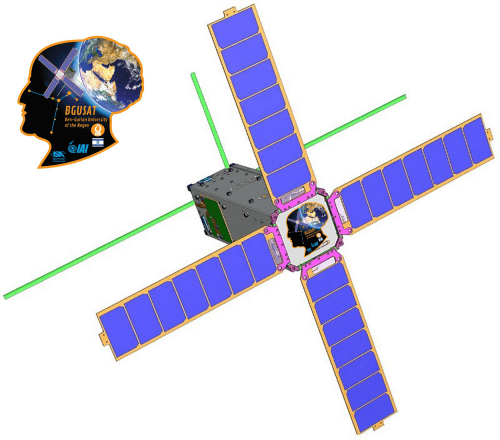BGUSAT and a SpacePharma satellite will be launched from India along with another hundred tiny satellites. BGUSAT is the first nano-satellite of its kind based on a new computer dedicated to nano-satellites, developed by the Aerospace Industry in collaboration with the Ministry of Science, and will be equipped with cameras to monitor climate change as part of a scientific mission by Ben-Gurion University of the Negev

A nano-satellite named BGUSAT (Ben-Gurion University of the Negev Satellite - a joint project of the Aerospace Industry and the Israel Space Agency in the Ministry of Science - will be launched tomorrow (Wednesday, February 15.2.2017, 10) into space as part of a scientific mission of Ben-Gurion University of the Negev. Its size The satellite is tiny 10x30x5 cm, the size of a milk carton, and weighs only 103 kg, and is equipped with special cameras capable of detecting different climatic phenomena and a control system that will allow selection of the photography and research areas. allow students and researchers to receive and analyze the data.The satellite will be launched tomorrow on a PSLV launcher from a launch base in India, along with another XNUMX other nanosatellites.
The official mission badge of the BGUSAT satellite was designed by Tal Inbar and by the designer Yigal Gabbay. The badge is designed in the shape of David Ben-Gurion's head, with an orange frame representing the Negev land. The satellite is seen looking at the Earth, and at the State of Israel. The aurora around the Earth represents one of the scientific topics that will be investigated by the satellite. The constellation "Yona" is shown on the badge as a symbol of peace and the civil purposes of the satellite. This constellation is best seen from Israel in February, the month of the launch. Also integrated into the symbol is the flag of Israel, the symbol of Ben-Gurion University of the Negev, the symbol of the aerospace industry that built the satellite, and the symbol of the Israel Space Agency.
The Minister of Science, Ofir Akunis, said that this is "another step in promoting cooperation between the government, industry and academia in order to jumpstart the Israeli space industry." Projects of this type will help maintain the position of the Israeli space industry in the world and will allow research in the field to be promoted."
The director of a space plant at IAI, Ofer Doron, said that: "We are proud to be part of an innovative technological project that opens the world of nanosatellites to new and diverse scientific missions. This nano-satellite joins a series of educational and academic activities carried out by the Aerospace Industry, as Israel's national space enterprise."
The Vice President and Dean of Research and Development at Ben-Gurion University of the Negev, Prof. Dan Blumberg, said that "nano-satellites enable activity in the fields of space engineering and space exploration at very low costs compared to what was acceptable in the past. This allows the academy to participate much more actively in the field and encourages innovation and entrepreneurship that comes from researchers and students."
In the satellite, whose name consists of the initials of "Ben-Gurion University of the Negev satellite", a dedicated computer was integrated for the first time, specially developed by the engineers of the aerospace industry for nano-satellites, which incorporates a unique chip developed by 'Ramon Chips' and has similar computing capabilities to those of the large satellite computers. This computer will also be integrated into the spacecraft of the SpaceIL association and the satellites of the Samson project. In addition, a dedicated camera, the only one of its kind, was developed at the Space Factory, in collaboration with the Microgeek company, which is capable of photographing a wide variety of weather phenomena in the short infrared range. The images transmitted by the satellite will be received by a ground station that will be built at Ben-Gurion University in the Negev and the Aerospace Industry. Using the satellite's cameras it will be possible to monitor climate changes, gases in the atmosphere such as CO2 and after sky glare. The camera is able to distinguish these phenomena in a better way compared to normal cameras.
Using the direction control system, it is possible to direct the satellite to photograph in defined areas and thus allow researchers to receive essential information. The research mission will focus on collecting data from parts of the atmosphere at the request of the researchers (regions where infrared waves are short). Another research topic that will be examined is the comparison of the type of information received from a nano satellite compared to information received from large satellites.
The students and researchers at the university combined knowledge from many fields such as software engineering, electrical engineering, earth sciences, industrial engineering and management and more. The combination resulted in the establishment of the receiving station to receive the images and will enable research in the field of weather. In addition to funding the launch of the satellite, the Israel Space Agency allocated to the Ministry of Science an additional amount of approximately one million shekels to fund research based on the images that will come from the satellite. The agency contacted the academic institutions in Israel and asked for proposals for research to be done on the basis of the data that the satellite will receive.
